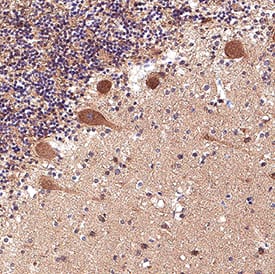Human/Mouse Neurexin 3/NRXN3 Antibody
R&D Systems, part of Bio-Techne | Catalog # AF5269


Key Product Details
Species Reactivity
Applications
Label
Antibody Source
Product Specifications
Immunogen
Ser35-Thr357
Accession # NP_620426
Specificity
Clonality
Host
Isotype
Scientific Data Images for Human/Mouse Neurexin 3/NRXN3 Antibody
Detection of Neurexin 3/NRXN3 in Human Brain Cerebellum.
Neurexin 3/NRXN3 was detected in immersion fixed paraffin-embedded sections of human brain cerebellum using Sheep Anti-Human/Mouse Neurexin 3/NRXN3 Antigen Affinity-purified Polyclonal Antibody (Catalog # AF5269) at 15 µg/mL for 1 hour at room temperature followed by incubation with the Anti-Sheep IgG VisUCyte™ HRP Polymer Antibody (Catalog # VC006). Before incubation with the primary antibody, tissue was subjected to heat-induced epitope retrieval using VisUCyte Antigen Retrieval Reagent-Basic (Catalog # VCTS021). Tissue was stained using DAB (brown) and counterstained with hematoxylin (blue). Specific staining was localized to Purkinje Neurons. View our protocol for IHC Staining with VisUCyte HRP Polymer Detection Reagents.Detection of Human/Mouse Neurexin 3/NRXN3 by Western Blot.
Western blot shows lysates of Mouse Brain. PVDF membrane was probed with 2 µg/mL of Sheep Anti-Human/Mouse Neurexin 3/NRXN3 Antigen Affinity-purified Polyclonal Antibody (Catalog # AF5269) followed by HRP-conjugated Anti-Sheep IgG Secondary Antibody (Catalog # HAF016). A specific band was detected for Neurexin 3/NRXN3 at approximately ~150 kDa (as indicated). This experiment was conducted under reducing conditions and using Western Blot Buffer Group 1.Applications for Human/Mouse Neurexin 3/NRXN3 Antibody
Immunohistochemistry
Sample: Immersion fixed paraffin-embedded sections of human brain (cerebellum and cortex)
Western Blot
Sample: Mouse brain
Formulation, Preparation, and Storage
Purification
Reconstitution
Formulation
Shipping
Stability & Storage
- 12 months from date of receipt, -20 to -70 °C as supplied.
- 1 month, 2 to 8 °C under sterile conditions after reconstitution.
- 6 months, -20 to -70 °C under sterile conditions after reconstitution.
Background: Neurexin 3/NRXN3
The alpha and beta forms of Neurexins 1‑3 are transmembrane neuronal glycoproteins which are transcribed from each of three NRXN genes that utilize alternate promoters. Like other Neurexins, the extracellular domain (ECD) of Neurexin 3 alpha contains six LNS domains interspersed with three EGF-like domains, while that of Neurexin 3 beta contains only the sixth LNS domain and no EGF-like domains (1‑3). Mature human Neurexin 3 beta is a 70 kDa glycosylated protein with a 528 amino acid (aa) ECD and a 56 aa cytoplasmic domain that contains a motif for binding PDZ scaffolding proteins (3‑5). Within comparable regions of the ECD, human Neurexin 3 beta shares 99% aa sequence identity with mouse and rat Neurexin 3 beta. It shares 65% aa sequence identity with comparable regions of the ECD of human Neurexin 1 beta and 2 beta. Alternative splicing of human Neurexin 3 beta generates multiple isoforms. There are potentially soluble and secreted variants and some which contain a fibronectin type III-like domain (4, 6). Neurexin 3 beta is widely expressed in the brain where it binds the postsynaptic Neuroligins 1, 2, and 3 (6‑9). Neurexin 3 beta may also be expressed in non-nervous tissues with a potentially cardiac-specific isoform (10). Human Neurexin 3 beta polymorphisms which affect the splicing pattern are associated with susceptibility to alcohol dependence (6). The Neurexin 3 beta genetic locus has been linked to opioid and nicotine addiction, and Neurexin 3 beta gene expression is up‑regulated after short term exposure of mice to cocaine (11‑13).
References
- Craig, A.M. and Y. Kang (2007) Curr. Opin. Neurobiol. 17:43.
- Dean, C. and T. Dresbach (2006) Trends Neurosci. 29:21.
- Lise, M.-F. and A. El-Husseini (2006) Cell. Mol. Life Sci. 63:1833.
- Rowen, L. et al. (2002) Genomics 79:587.
- Ushkaryov, Y. A. et al. (1994) J. Biol. Chem. 269:11987.
- Hishimoto, A. et al. (2007) Hum. Mol. Genet. 16:2880.
- Ullrich, B. et al. (1995) Neuron 14:497.
- Ichtchenko, K. et al. (1996) J. Biol. Chem. 271:2676.
- Ichtchenko, K. et al. (1995) Cell 81:435.
- Occhi, G. et al. (2002) Biochem. Biophys. Res. Commun. 298:151.
- Lachman, H.M. et al. (2007) Hum. Mol. Genet. 16:1327.
- Bierut, L.J. et al. (2007) Hum. Mol. Genet. 16:24.
- Kelai, S. et al. (2008) Neuroreport 19:751.
Alternate Names
Gene Symbol
UniProt
Additional Neurexin 3/NRXN3 Products
Product Documents for Human/Mouse Neurexin 3/NRXN3 Antibody
Product Specific Notices for Human/Mouse Neurexin 3/NRXN3 Antibody
For research use only
